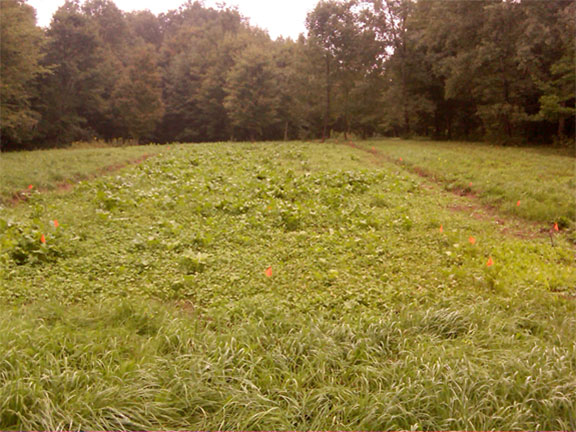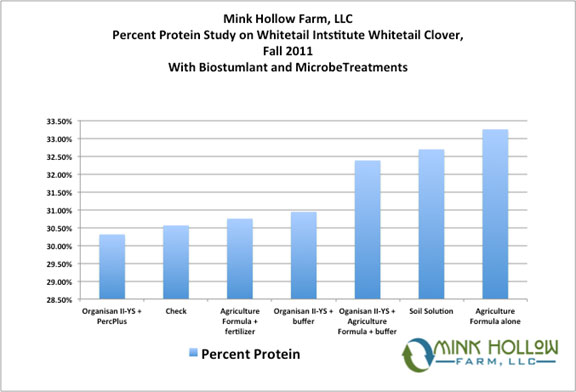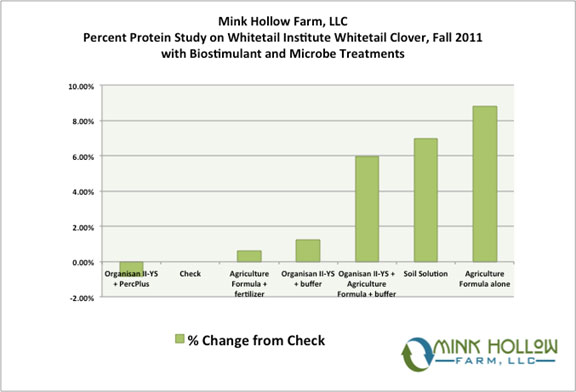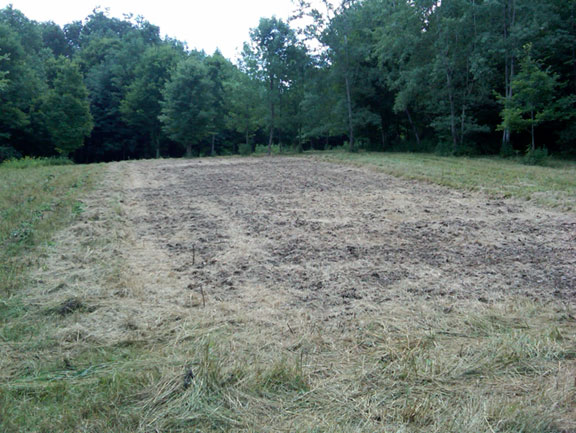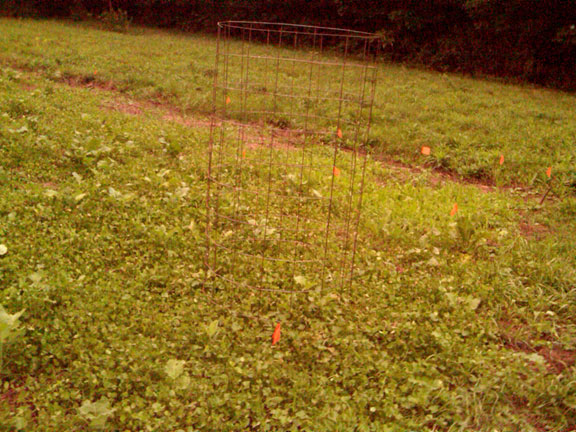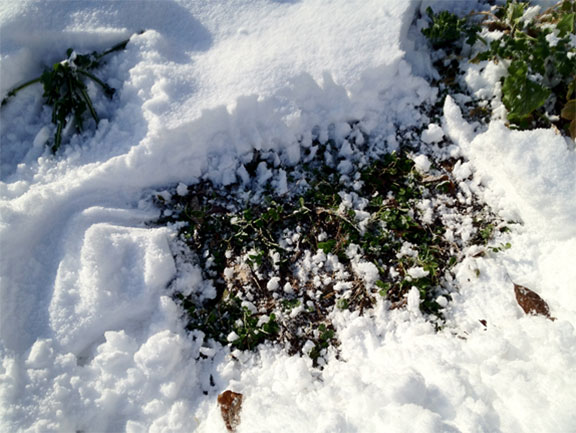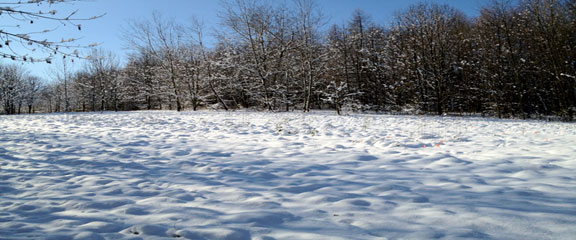Mink Hollow Farm, LLC, Percent Protein Study in Whitetail Institute Imperial Whitetail™ Brand Clover, Fall 2011, with Biostimulant and Microbe Treatments
Last Updated 2/16/12
Objective: To initiate a preliminary study to determine the effect of specific biostimulant and microbe treatments on the percent protein found in Whitetail Institute Imperial Whitetail Clover during late season (Sept. – Nov.) in western New York State.
Importance: Percent protein seems to be the primary method to measure quality in clover used for wildlife food plots. Protein increases the ability of deer to grow, remain healthy and develop antlers.
Conclusions: The products that are designed to influence soil microbial activity or provide microbial inoculation, resulting in nutrient release and availability, appear to have increased percent protein in clover. These products are Agriculture Formula from Bio-S.I. and Soil Solution from DeltAg. An increase of percent protein from 7% to 9% was observed. This increase may justify applications of these products in wildlife food plots, for deer, to increase animal health going into the rut and the following stress of winter weather.
The other products warrant further testing to determine their value during other portions of the growing season such as spring re-growth, re-growth following summer mowing, dry conditions, and disease favoring conditions,
Products used:
Whitetail Institute of North America, Inc., Imperial Whitetail™ Brand Clover – the first and only clover developed specifically for whitetail deer. Provides up to 35% antler building protein.
DeltAg, PercPlus™ – designed to enhance root development, growth, overall plant health, and build tolerance to environmental stress.
DeltAg, Soil Solution™ – designed to stimulate microflora which increases nutrient availability.
Venture Chemical, OII-YS™ The Natural Spreader Sticker – (this product contains chitosan which has documented biostimulant activity).
Bio-S.I.™ Technology, LLC., Agriculture Formula – is a soil inoculant with a broad and diverse spectrum of naturally occurring beneficial microbes and enzymes for rebuilding the soil resulting in increases nutrient availability.
Date of product application – September 3, 2011
Date of leaf sample collection – November 21, 2011
Study Results for percent protein:
The Soil: The target pH for clover is 6.5. Our plot, previously on non-cultivated farmland, has a pH of 5.5, which is low. Lime was applied in 2011 but future annual applications will be necessary to increase the pH. This plot tested high for potassium (K), Magnesium (Mg), Calcium (Ca), and Manganese (Mn), but low-medium for Phosphorous (P) and Boron (B). Sulfur, Zinc, Iron, and Copper, and organic matter were not tested. It is evident that there is an adequate amount of organic matter, probably greater than 2%. The soil is a heavy clay loam with excellent surface drainage.
Planting:
The food plot was planted in mid July 2011. This is the recommended time to plant clover for food plots in western NY State. The plot is approximately 6000 sq. ft. (.14 acre).
The plot was planted with Whitetail Institute “Whitetail Clover” and “Double-Cross” Whitetail Clover / Brassica mix. I mixed the two seed mixes together because I did not want to be overcrowded with brassicas. More seed than recommended was applied to make sure a good stand was established. The seedbed was less than ideal with a some excessive plant trash material in places. Generally conditions were dry during germination.
Planting Progression: (site was weedy and non-cultivated for at least 15 years; acid clay loam soil with some nice surface topsoil)
Day 1 – Spay glyphosate, PercPlus (biostimulant), Soil Solution (biostimulant), Heat (adjuvant), and Blue Dye. Wait for plant yellowing.
Day 3 – Obvious yellowing – bush-hogged as low as possible, raked, disked.
Day 4 – Spread lime and 10-10-10 fertilizer. Disked in the fertilizer and lime. For the last disking, the adjustable disc blades were oriented as straight as possible resulting in a more level seedbed. (this is an advantage of adjustable disk blades)
Day 5 – Spread seed without any further cultivation.
The plot was growing well but with a few low germination areas by the second week of August. The plants were less than 2 inches tall for the most part, with some noticeable grassy weeds in certain areas. The brassica percentage appeared sparse, but turned out to be perfect by November. The brassicas included rape, kale, and turnips. Overall there was good germination. There was a lot of clover, some brassicas, and some broadleaf and grassy weeds, but the clover became dominant. There are four test plots with other Whitetail institute seed mixes, “Chick magnet”, “Alfa-Rack Plus”, “Chicory Plus”, and “Imperial Whitetail Extreme” (within this plot). These plots are approximately 4 ft. by 5 ft. (20 sq. ft.). Three out of four of these mini plots were growing well. The plots were helped by timely rains during predominantly dry conditions.
The plot was sprayed with sprayed with sethoxydim (Poast Plus) for grass control immediately prior to the trial applications on Sept. 3, 2011. The clover and grass was 5 to 8 inches tall with brassicas 8 to 12 inches tall. The purple top turnips had bulbs forming about 1½ inches in diameter.
Trial Applications: A new one gallon pump-up sprayer was used to spray the product test plots. One gallon was used to spray 1000 sq. ft.. A double spray pattern was used; half being applied in one direction and half applied in the other direction to ensure uniform coverage.
Plots on September 3rd, 2011
Product Test Plot Descriptions:
1) Agriculture Formula & Fertilizer (Miracle Gro® 20-20-20 plus minors)
a. 2 oz. Agriculture Formula + 1 tablespoon Miracle-Gro fertilizer
2) Organisan II-YS alone
a. 6 oz. Organisan II-YS + 2 tablespoons of vinegar
3) Agriculture Formula & Organisan II-YS
a. 2 oz. Agriculture Formula + 6 oz. Organisan II-YS + 2 tablespoons of vinegar
4) Agriculture Formula Alone
a. 2 oz. Agriculture Formula
5) Organisan II-YS & PercPlus (rate based on 1000 sq. ft.)
a. 6 oz. Organisan II-YS + 2 oz PercPlus
6) Soil Solution alone (rate based on 1000 sq. ft.)
a. 2 oz. Soil Solution
7) Check – no spray application
Miracle-Gro® fertilizer
24% nitrogen (N) 0.15% iron (Fe)
8% phosphate (P) 0.07% copper (Cu)
16% potash (K) 0.05% manganese (MN)
0.02% boron (B) 0.0005% molybdenum (Mo)
0.06% zinc (Zn)
Cage for excluding deer feeding:
Plot Layout:
Check DeltAg Soil Solution
Agriculture Formula + Fertilizer (Miracle Grow)
Organisan II-YS + vinegar
Organisan II-YS + Agriculture Formula + vinegar
Agriculture Formula alone
Organisan II-YS + DeltAg PercPlus
Check DeltAg Soil Solution
Spray Date: Sept. 3, 2011
Sample Collection Date: Nov. 21, 2011
- Large Plots 1000 sq. ft.
- Medium Plots 500 sq. ft.
- Small Plots 250 sq. ft.
- vinegar added to lower the pH of spray solution
Additional Notes:
Stand Longevity: Another interest is stand longevity, which will encourage a long term study on the same plots over a series of years. The length of time to replanting would be a savings of time and money to a food plot manager. The materials used in this trial have the potential to:
- increase release of nutrients from the soil
- increase nutrient absorption by the crop
- increase drought resistance
- increase root development
- decrease pathogens
- decrease transpiration
- decrease insect and nematode pressure
- decrease soil compaction
These attributes would have a tendency to lengthen the number of years to replanting. Weed management would also be key to stand longevity. Some of these products when applied with herbicides may not only increase the effectiveness of the herbicide, but also facilitate an application timing without making a special trip across the field.
Clover and Brassicas living insulated beneath the snow.
2010 Plots (non study related):
Wildlife food plots planted in 2010 did very well during 2011. Whitetail Clover and AntlerKing clover with Brassicas (3 plots) were planted. These plots were planted in mid July 2010. The deer kept the clover trimmed very close to the ground. The deer ate the heck out of the brassicas during the fall, after a good killing frost and into the winter, through heavy snow. I’m sure the brassicas helped my neighbor and his girlfriend to harvest two really nice bucks very close to the plots. The brassicas were eaten down to the nubs by spring.
The brassicas went to seed in July 2011 and re-seeded themselves in the established clover but these plants remained small and insignificant; probably from competition with the clover.
July 2010 planting:
Plot A – Combination of Whitetail Institute Whitetail Clover and Antler King Trophy Clover Mix (including clover varieties, chicory, and rape)
Plot B – Whitetail Institute Whitetail Clover
Plot C – Antler King Trophy Clover Mix (including clover varieties, chicory, and rape)
Maintenance:
Poast Plus was applied to these plots to control grassy weeds during the summer of 2011. These applications proved to be very effective and will extend the life of these plots.
These plots did well in 2011 but will need some broadleaf weed control in 2012. Assuming weed control can be achieved successfully, they will be available for further product test plots. Each plot is approximately 2000 sq. ft..
Clover planted on excavated farm road site:
Some remaining seed was also planted on an excavated area where I installed two drainage pipes on excavated, non-limed, non-fertilized, heavy clay subsoil. I planted that seed in mid August 2011. By Aug. 30th this seed was germinated and approximately 1” tall. This “plot” is at least 3000 sq. ft. It is actually planted on a farm road but will only be used occasionally. This planting will be watched for longevity and erosion control. I intend to make some lime applications to bring up the soil pH.
2011 Food Plots under snow during the November hunting season.

